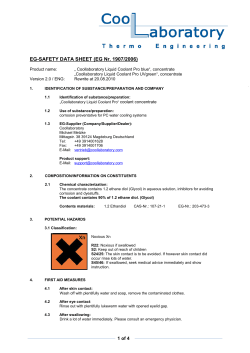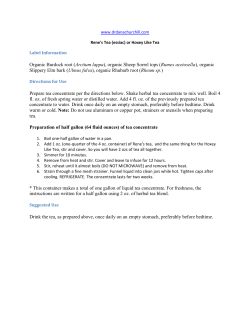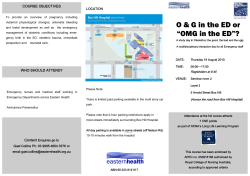
Pilot plant tests confirm Hawsons’ high grade concentrate Highlights
ASX ANNOUNCEMENT ABN: 63 095 117 981 | ASX: CAP We find it. We prove it. We make it possible. 22 October 2014 Pilot plant tests confirm Hawsons’ high grade concentrate Highlights Results boost confidence in project cost estimates for eastern Australia’s biggest magnetite project Results differentiate Hawsons project, confirming that simple, low energy processing, including single stage grinding, can produce high grade concentrate without the technical challenges of harder magnetite ores Pilot plant test work produces high grade, low impurity concentrate and confirms processing flow sheet assumptions Separate floatation results show potential to produce a direct reduction (DR) grade pellet feed concentrate at low cost, expanding project options and boosting development prospects Fe% SiO2% Al2O3% P% S% Hawsons flow sheet pilot plant test concentrate 68.3 3.56 0.39 0.007 <0.001 Hawsons floatation bench test concentrate 69.1 1.19 0.54 0.025 NA Table 1 Concentrate analysis from recent test work Carpentaria Exploration Limited (ASX:CAP) announced today metallurgical test work results from two different test work programs on mineralisation from the Company’s flagship Hawsons Iron Project near Broken Hill, confirming its potential to produce a premium-grade product. Level 6, 345 Ann Street Brisbane Qld 4000 PO Box 10919, Adelaide St Brisbane Qld 4000 e-mail: info@capex.net.au For further information contact: Quentin Hill Managing Director Phone: 07 3220 2022 In a boost for eastern Australia’s biggest magnetite project, the results demonstrate that a high grade, low impurity concentrate can be produced at Hawsons with low energy use. This is consistent with previous project assumptions and highlights the project’s technical advantages. The results also provide added confidence that the project can meet its study target of free on board (FOB) Port Pirie costs of USD50-52/t concentrate. Carpentaria’s Managing Director, Quentin Hill, said the latest studies added to the Company’s confidence in the Hawsons project and its ability to become the cornerstone of a long lasting, low cost premium iron business. “These test work results are very significant, giving us tremendous confidence that the Hawsons deposit can be cheaply and simply processed into some of the highest grade iron concentrate in the market,” Mr Hill said. “The high grade results allow us to position the product at the premium end of the market, which attracts significantly higher prices because of the efficiency, pollution reduction and steel quality advantages gained from high grade feed stock, in stark contrast to the discounts for lower grade products. ASX ANNOUNCEMENT “The ability to upgrade to a direct reduction (DR) quality feed also increases the size of the potential market for the Hawsons concentrate, thereby enhancing the project’s development and investment prospects.” The Hawsons joint venture will now seek to optimise the benefits of the latest results in terms of market position, product pricing and investment potential. Highlighting the value of a higher grade product, the current price for (as quoted on custeel.com, 22 October 2014) 62% fines is USD82/t and 66% Fe concentrate is USD96/t. This translates to between USD100/t and USD106/t for Hawsons 69% product, a USD20 uplift from prices received for the typical Pilbara product. An additional premium may even be available for DR quality products. Pilot plant test work – Western Australia A test work program underway at the ALS Metallurgy Iron Ore Technical Centre in Perth, Western Australia, is testing the assumptions of the processing flow sheet. Sample and crushing Both drill core and RC chips representative of the entire deposit were sampled. During the crushing stage, 2.7 tonnes of drill core and 5.3 tonnes of RC chips were crushed to less than 1 mm in size, using impact crushers to maximise the generation of fines consistent with flow sheet assumptions. Rougher magnetic separation The crushed drill core was passed through the rougher (first pass) magnetic separator and 45% of material was rejected as tailings and is materially in line with the flow sheet assumption of 50%, based on earlier crushing work from the CSIRO. This high rejection to tailings reduces the load on the rest of the circuit and is a significant cost benefit. Ball milling The target grind size for the ball milling was 80% passing 26 microns, and this was achieved for approximately 8 t of the combined RC and drill core sample using only 6.9 kWh/t of energy. Other bench scale tests carried out concurrently on drill core samples returned an energy consumption of between 9.7 - 10.7 kWh/t to reduce the concentrate from -1mm to the target grind size. Carpentaria’s plant design assumptions used in cost estimates was 12 kWh/t. This work has proven that ball milling can reduce the Hawsons rock to the right grind size for successful liberation of high grade magnetite. Cleaner magnetic separation All ball mill discharge was passed through the cleaner magnetic separator, with concentrate grades of between 66% Fe and 68% Fe achieved. Magnetic losses through the circuit, as tested by Davis Tube recovery tests on the tails, were less than 5%, in line with assumptions. Hydroseparation Hydroseparation tests use upwelling water to lift lighter, silica dominant and slime particles out of the concentrate. Bench scale hydroseparation tests upgraded the concentrate to the premium grades for the project (see the table on page 1) with minimal losses. Commenting on the test work, Hawsons Project Technical Director Ray Koenig said, “These results are very pleasing and based on this work, there is no cause to materially change our assumptions. The circuit is simple, and offers very low technical and operating risk. 2 ASX ANNOUNCEMENT “Hydroseparators are very common in North American magnetite operations, and this work clearly demonstrates the advantages of the Hawsons ore. The secret is that the material mostly separates along grain boundaries, allowing simple liberation of pure magnetite. “The results from one of the most advanced and experienced testing centres for iron ore clearly moves our flow sheet from conceptual to probable, and now allows us to plan a larger run feed with a deposit master sample.” The test work as well as the extensive Davis Tube testing of the resource has shown consistent results throughout the life of the project. Earlier pelletising test work has also shown positive results, meaning that both blast furnace and DR quality pellets could now be possible. Photo 1 Pilot plant cleaner magnetic separator in action, Iron Ore Technical Photo 2 Hydroseparator with Hawsons material, Iron Ore Technical Centre, WA Centre, WA Floatation test work – South Africa In separate test work, bench scale floatation tests done on 60 kg of RC chips representative of the Hawsons deposit have also returned encouraging results. The work was carried out by industry experts with proprietary technology at a university laboratory in South Africa. The tests confirmed that the Hawsons ore has the potential to beneficiate into a DR suitable feed and attract even higher premiums. Following routine sighter grinding and low intensity magnetic recovery tests, the sample size was reduced via ball milling to 90% passing 106 microns and put through a wet low intensity magnetic separator. The subsequent concentrate was further ground to 90% passing 25 microns and put through a further stage of wet low intensity magnetic separation that produced a 66% Fe concentrate, with recoveries in line with earlier test work. 3 ASX ANNOUNCEMENT This concentrate was then put through conventional floatation tests designed to remove the silica dominant particles. This resulted in the sample being upgraded to 69.1% Fe and 1.19% silica with a 91% recovery by mass. The highest operating cost in floatation is typically the cost of the collector, and the results were achieved using only 60 g/t of collector consumed (compared with more typical ranges of 300-500 g/t). This test work is ongoing and the Company will investigate the potential cost advantages of this technology, however it seems likely that floatation using the tested method and the Hawsons material can achieve materially lower costs with savings of approximately USD2.70/t on typical floatation circuits using current collector costs. This, once again, demonstrates the advantages of the Hawsons deposit. Both test work programs are ongoing and the full results will be analysed when available. However, a large part of the work has been done and has provided very positive results. While part of the tests were conducted on RC chips which have an already fine feed size, based on bench scale test work of drill core the Company is extremely confident that the targeted grade will be achievable with ball milling as the only grinding stage. This demonstrates that the Hawsons deposit is very different from other magnetite deposits and will not have the high costs and technical challenges common for harder magnetite ores. The next step is to obtain a project master sample from which to carry out a full scale pilot plant run, to add further confidence in the Hawsons product. “Carpentaria continues to build a platform for further investment in the Hawsons project by de-risking and enhancing its development prospects in a targeted and measured way, backed by our experienced board and management. With favourable access to infrastructure, a superior product and targeted low costs, Hawsons is capable of becoming a long-term producer of premium iron concentrate and generating significant growth in shareholder value,” Mr Hill said. For further information please contact: Quentin Hill Managing Director +61 7 3220 2022 We find it. We prove it. We make it possible. The information in this report that relates to Exploration Results, Exploration Targets and Resources is based on information evaluated by Mr Q.S. Hill who is a member of the Australian Institute of Geoscientists (MAIG) and who has sufficient experience relevant to the style of mineralisation and type of deposit under consideration and to the activity which he is undertaking to qualify as a Competent Person as defined in the 2012 Edition of the Australasian Code for Reporting of Exploration Results, Mineral Resources and Ore Reserves (the “JORC Code”). Mr Hill is a Director of Carpentaria Exploration Ltd and he consents to the inclusion in the report of the Exploration Results in the form and context in which they appear. 4
© Copyright 2025




















